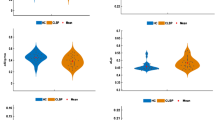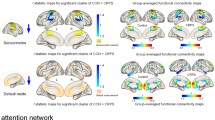Abstract
Dysfunction of the cingulo-frontal-parietal (CFP) cognitive attention network has been associated with the pathophysiology of chronic low back pain (cLBP). However, the direction of information processing within this network remains largely unknown. We aimed to study the effective connectivity among the CFP regions in 36 cLBP patients and 36 healthy controls by dynamic causal modeling (DCM). Both the resting-state and task-related (Multi-Source Interference Task, MSIT) functional magnetic resonance imaging (fMRI) data were collected and analyzed. The relationship between the effective connectivity of the CFP regions and clinical measures was also examined. Our results suggested that cLBP had significantly altered resting-state effective connectivity of the prefrontal cortex (PFC)-to-mid-cingulate cortex (MCC) (increased) and MCC-to-left superior parietal cortex (LPC) (decreased) pathways as compared with healthy controls. MSIT-related DCM suggested that the interference task could significantly increase the effective connectivity of the right superior parietal cortex (RPC)-to-PFC and RPC-to-MCC pathways in cLBP than that in healthy controls. The control task could significantly decrease the effective connectivity of the MCC-to-LPC and MCC-to-RPC pathways in cLBP than that in healthy controls. The endogenous connectivity of the PFC-to-RPC pathway in cLBP was significantly lower than that in healthy controls. No significant correlations were found between the effective connectivity within CFP networks and pain/depression scores in patients with cLBP. In summary, our findings suggested altered effective connectivity in multiple pathways within the CFP network in both resting-state and performing attention-demanding tasks in patients with cLBP, which extends our understanding of attention dysfunction in patients with cLBP.





Similar content being viewed by others
References
Beckmann, C. F., Jenkinson, M., & Smith, S. M. (2003). General multilevel linear modeling for group analysis in FMRI. Neuroimage, 20(2), 1052–1063. https://doi.org/10.1016/S1053-8119(03)00435-X
Buchel, C., & Friston, K. J. (1997). Modulation of connectivity in visual pathways by attention: cortical interactions evaluated with structural equation modelling and fMRI. Cereb Cortex, 7(8), 768–778. https://doi.org/10.1093/cercor/7.8.768
Bush, G., Luu, P., & Posner, M. I. (2000). Cognitive and emotional influences in anterior cingulate cortex. Trends Cogn Sci, 4(6), 215–222. https://doi.org/10.1016/s1364-6613(00)01483-2
Bush, G., Shin, L. M., Holmes, J., Rosen, B. R., & Vogt, B. A. (2003). The Multi-Source Interference Task: validation study with fMRI in individual subjects. Mol Psychiatry, 8(1), 60–70. https://doi.org/10.1038/sj.mp.4001217
Bush, G., & Shin, L. M. (2006). The Multi-Source Interference Task: an fMRI task that reliably activates the cingulo-frontal-parietal cognitive/attention network. Nature Protocols, 1(1), 308–313. https://doi.org/10.1038/nprot.2006.48
Corbetta, M. (1998). Frontoparietal cortical networks for directing attention and the eye to visual locations: identical, independent, or overlapping neural systems? Proceedings of the National Academy of Sciences of the United States of America, 95(3), 831–838. https://doi.org/10.1073/pnas.95.3.831
Corbetta, M., Kincade, J. M., Ollinger, J. M., McAvoy, M. P., & Shulman, G. L. (2000). Voluntary orienting is dissociated from target detection in human posterior parietal cortex. Nature Neuroscience, 3(3), 292–297. https://doi.org/10.1038/73009
Daunizeau, J., David, O., & Stephan, K. E. (2011). Dynamic causal modelling: a critical review of the biophysical and statistical foundations. Neuroimage, 58(2), 312–322. https://doi.org/10.1016/j.neuroimage.2009.11.062
de Heer, E. W., Gerrits, M. M., Beekman, A. T., Dekker, J., van Marwijk, H. W., de Waal, M. W., et al. (2014). The association of depression and anxiety with pain: a study from NESDA. PLoS One, 9(10), e106907. https://doi.org/10.1371/journal.pone.0106907
Deng, Y., Wang, X., Wang, Y., & Zhou, C. (2018). Neural correlates of interference resolution in the multi-source interference task: a meta-analysis of functional neuroimaging studies. Behavioral and Brain Functions, 14(1), 8. https://doi.org/10.1186/s12993-018-0140-0
Dick, B. D., & Rashiq, S. (2007). Disruption of attention and working memory traces in individuals with chronic pain. Anesthesia & Analgesia, 104(5), 1223-9, tables of contents. https://doi.org/10.1213/01.ane.0000263280.49786.f5
Dworkin, R. H., Turk, D. C., Revicki, D. A., Harding, G., Coyne, K. S., Peirce-Sandner, S., et al. (2009). Development and initial validation of an expanded and revised version of the Short-form McGill Pain Questionnaire (SF-MPQ-2). Pain, 144(1–2), 35–42. https://doi.org/10.1016/j.pain.2009.02.007
Eccleston, C. (1994). Chronic pain and attention: a cognitive approach. British Journal of Clinical Psychology, 33(4), 535–547. https://doi.org/10.1111/j.2044-8260.1994.tb01150.x
Etkin, A., Egner, T., & Kalisch, R. (2011). Emotional processing in anterior cingulate and medial prefrontal cortex. Trends in Cognitive Sciences, 15(2), 85–93. https://doi.org/10.1016/j.tics.2010.11.004
Friston, K. J., Harrison, L., & Penny, W. (2003). Dynamic causal modelling. NeuroImage, 19(4), 1273–1302. https://doi.org/10.1016/s1053-8119(03)00202-7
Friston, K. (2009). Causal modelling and brain connectivity in functional magnetic resonance imaging. PLOS Biology, 7(2), e33. https://doi.org/10.1371/journal.pbio.1000033
Friston, K. J. (2011). Functional and effective connectivity: a review. Brain Connectivity, 1(1), 13–36. https://doi.org/10.1089/brain.2011.0008
Friston, K., Moran, R., & Seth, A. K. (2013). Analysing connectivity with Granger causality and dynamic causal modelling. Current Opinion in Neurobiology, 23(2), 172–178. https://doi.org/10.1016/j.conb.2012.11.010
Friston, K. J., Kahan, J., Biswal, B., & Razi, A. (2014). A DCM for resting state fMRI. Neuroimage, 94, 396–407. https://doi.org/10.1016/j.neuroimage.2013.12.009
Friston, K. J., Litvak, V., Oswal, A., Razi, A., Stephan, K. E., van Wijk, B. C. M., et al. (2016). Bayesian model reduction and empirical Bayes for group (DCM) studies. Neuroimage, 128, 413–431. https://doi.org/10.1016/j.neuroimage.2015.11.015
Goebel, R., Roebroeck, A., Kim, D. S., & Formisano, E. (2003). Investigating directed cortical interactions in time-resolved fMRI data using vector autoregressive modeling and Granger causality mapping. Magnetic Resonance Imaging, 21(10), 1251–1261. https://doi.org/10.1016/j.mri.2003.08.026
Grisart, J. M., & Plaghki, L. H. (1999). Impaired selective attention in chronic pain patients. European Journal of Pain, 3(4), 325–333. https://doi.org/10.1053/eujp.1999.0138
Hamilton, M. (1960). A rating scale for depression. Journal of Neurology, Neurosurgery, and Psychiatry, 23, 56–62. https://doi.org/10.1136/jnnp.23.1.56
Hartvigsen, J., Hancock, M. J., Kongsted, A., Louw, Q., Ferreira, M. L., Genevay, S., et al. (2018). What low back pain is and why we need to pay attention. The Lancet, 391(10137), 2356–2367. https://doi.org/10.1016/s0140-6736(18)30480-x
Henseler, J., Ringle, C. M., & Sarstedt, M. (2014). A new criterion for assessing discriminant validity in variance-based structural equation modeling. Journal of the Academy of Marketing Science, 43(1), 115–135. https://doi.org/10.1007/s11747-014-0403-8
Hubbard, C. S., Hong, J., Jiang, Z., Ebrat, B., Suyenobu, B., Smith, S., et al. (2015). Increased attentional network functioning related to symptom severity measures in females with irritable bowel syndrome. Neurogastroenterology & Motility, 27(9), 1282–1294. https://doi.org/10.1111/nmo.12622
Isenburg, K., Mawla, I., Loggia, M. L., Ellingsen, D. M., Protsenko, E., Kowalski, M. H., et al. (2020). Increased salience network connectivity following manual therapy is associated with reduced pain in chronic low back pain patients. The Journal of Pain. https://doi.org/10.1016/j.jpain.2020.11.007
Jenkinson, M., Bannister, P., Brady, M., & Smith, S. (2002). Improved optimization for the robust and accurate linear registration and motion correction of brain images. Neuroimage, 17(2), 825–841. https://doi.org/10.1016/s1053-8119(02)91132-8
Jenkinson, M., Beckmann, C. F., Behrens, T. E., Woolrich, M. W., & Smith, S. M. (2012). Fsl. Neuroimage, 62(2), 782–90. https://doi.org/10.1016/j.neuroimage.2011.09.015
Jorge, L. L., Gerard, C., & Revel, M. (2009). Evidences of memory dysfunction and maladaptive coping in chronic low back pain and rheumatoid arthritis patients: challenges for rehabilitation. European Journal of Physical and Rehabilitation Medicine, 45(4), 469–477
Kewman, D. G., Vaishampayan, N., Zald, D., & Han, B. (1991). Cognitive impairment in musculoskeletal pain patients. The International Journal of Psychiatry in Medicine, 21(3), 253–262. https://doi.org/10.2190/FRYK-TMGA-AULW-BM5G
Kondo, H., Osaka, N., & Osaka, M. (2004). Cooperation of the anterior cingulate cortex and dorsolateral prefrontal cortex for attention shifting. Neuroimage, 23(2), 670–679. https://doi.org/10.1016/j.neuroimage.2004.06.014
Kucyi, A., Salomons, T. V., & Davis, K. D. (2013). Mind wandering away from pain dynamically engages antinociceptive and default mode brain networks. Proceedings of the National Academy of Sciences of the United States of America, 110(46), 18692–18697. https://doi.org/10.1073/pnas.1312902110
Lamoth, C. J., Stins, J. F., Pont, M., Kerckhoff, F., & Beek, P. J. (2008). Effects of attention on the control of locomotion in individuals with chronic low back pain. Journal of NeuroEngineering and Rehabilitation, 5, 13. https://doi.org/10.1186/1743-0003-5-13
Kucyi, A., Moayedi, M., Weissman-Fogel, I., Goldberg, M. B., Freeman, B. V., Tenenbaum, H. C., et al. (2014). Enhanced medial prefrontal-default mode network functional connectivity in chronic pain and its association with pain rumination. The Journal of Neuroscience, 34(11), 3969–3975. https://doi.org/10.1523/JNEUROSCI.5055-13.2014
Lee, J. J., Kim, H. J., Ceko, M., Park, B. Y., Lee, S. A., Park, H., et al. (2021). A neuroimaging biomarker for sustained experimental and clinical pain. Nature Medicine, 27(1), 174–182. https://doi.org/10.1038/s41591-020-1142-7
Legrain, V., Iannetti, G. D., Plaghki, L., & Mouraux, A. (2011). The pain matrix reloaded: a salience detection system for the body. Progress in Neurobiology, 93(1), 111–124. https://doi.org/10.1016/j.pneurobio.2010.10.005
Legrain, V. (2017). Lost in space: do somatic symptoms affect the perception of extra-somatic stimuli? Brain, 140(9), 2254–2256. https://doi.org/10.1093/brain/awx188
Li, J., Feng, Y., Han, J. S., Fan, B. F., Wang, J. S., Wei, X., et al. (2013). Multi-centered linguistic adaptation and validation of short-form Mcgill Pain Questionnaire-2. Chinese Journal of Pain Medicine, 19(1), 42–46. https://doi.org/10.3969/j.issn.1006-9852.2013.01.014
Liu, J., Chen, L., Chen, X., Hu, K., Tu, Y., Lin, M., et al. (2019). Modulatory effects of different exercise modalities on the functional connectivity of the periaqueductal grey and ventral tegmental area in patients with knee osteoarthritis: a randomised multimodal magnetic resonance imaging study. British Journal of Anaesthesia, 123(4), 506–518. https://doi.org/10.1016/j.bja.2019.06.017
Maher, C., Underwood, M., & Buchbinder, R. (2017). Non-specific low back pain. Lancet, 389(10070), 736–747. https://doi.org/10.1016/S0140-6736(16)30970-9
Mao, C. P., Zhang, Q. L., Bao, F. X., Liao, X., Yang, X. L., & Zhang, M. (2014). Decreased activation of cingulo-frontal-parietal cognitive/attention network during an attention-demanding task in patients with chronic low back pain. Neuroradiology, 56(10), 903–912. https://doi.org/10.1007/s00234-014-1391-6
Mao, C. P., Chen, F. R., Huo, J. H., Zhang, L., Zhang, G. R., Zhang, B., et al. (2020). Altered resting-state functional connectivity and effective connectivity of the habenula in irritable bowel syndrome: A cross-sectional and machine learning study. Human Brain Mapping, 41(13), 3655–3666. https://doi.org/10.1002/hbm.25038
McPhee, M. E., & Graven-Nielsen, T. (2021). Positive affect and distraction enhance whereas negative affect impairs pain modulation in patients with recurrent low back pain and matched controls. Pain. https://doi.org/10.1097/j.pain.0000000000002442
Meerwijk, E. L., Ford, J. M., & Weiss, S. J. (2013). Brain regions associated with psychological pain: implications for a neural network and its relationship to physical pain. Brain Imaging and Behavior, 7(1), 1–14. https://doi.org/10.1007/s11682-012-9179-y
Milham, M. P., Banich, M. T., Webb, A., Barad, V., Cohen, N. J., Wszalek, T., et al. (2001). The relative involvement of anterior cingulate and prefrontal cortex in attentional control depends on nature of conflict. Brain Research. Cognitive Brain Research, 12(3), 467–473. https://doi.org/10.1016/s0926-6410(01)00076-3
Moore, D. J., Meints, S. M., Lazaridou, A., Johnson, D., Franceschelli, O., Cornelius, M., et al. (2019). The effect of induced and chronic pain on attention. The Journal of Pain, 20(11), 1353–1361. https://doi.org/10.1016/j.jpain.2019.05.004
Nacher, V., Hassani, S. A., & Womelsdorf, T. (2019). Asymmetric effective connectivity between primate anterior cingulate and lateral prefrontal cortex revealed by electrical microstimulation. Brain Structure and Function, 224(2), 779–793. https://doi.org/10.1007/s00429-018-1806-y
Naushad, N., Dunn, L. B., Muñoz, R. F., & Leykin, Y. (2018). Depression increases subjective stigma of chronic pain. Journal of Affective Disorders, 229, 456–462. https://doi.org/10.1016/j.jad.2017.12.085
Ng, S. K., Urquhart, D. M., Fitzgerald, P. B., Cicuttini, F. M., Hussain, S. M., & Fitzgibbon, B. M. (2018). The relationship between structural and functional brain changes and altered emotion and cognition in chronic low back pain brain changes: a systematic review of MRI and fMRI studies. The Clinical Journal of Pain, 34(3), 237–261. https://doi.org/10.1097/AJP.0000000000000534
Penny, W. D., Stephan, K. E., Mechelli, A., & Friston, K. J. (2004). Comparing dynamic causal models. Neuroimage, 22(3), 1157–1172. https://doi.org/10.1016/j.neuroimage.2004.03.026
Penny, W. D., Stephan, K. E., Daunizeau, J., Rosa, M. J., Friston, K. J., Schofield, T. M., et al. (2010). Comparing families of dynamic causal models. PLOS Computational Biology, 6(3), e1000709. https://doi.org/10.1371/journal.pcbi.1000709
Poldrack, R. (2006). Can cognitive processes be inferred from neuroimaging data? Trends in Cognitive Sciences, 10(2), 59–63. https://doi.org/10.1016/j.tics.2005.12.004
Preller, K. H., Razi, A., Zeidman, P., Stampfli, P., Friston, K. J., & Vollenweider, F. X. (2019). Effective connectivity changes in LSD-induced altered states of consciousness in humans. Proceedings of the National Academy of Sciences of the United States of America, 116(7), 2743–2748. https://doi.org/10.1073/pnas.1815129116
Quarto, T., Paparella, I., De Tullio, D., Viscanti, G., Fazio, L., Taurisano, P., et al. (2018). Familial risk and a genome-wide supported DRD2 variant for schizophrenia predict lateral prefrontal-amygdala effective connectivity during emotion processing. Schizophrenia Bulletin, 44(4), 834–843. https://doi.org/10.1093/schbul/sbx128
Seminowicz, D. A., Wideman, T. H., Naso, L., Hatami-Khoroushahi, Z., Fallatah, S., Ware, M. A., et al. (2011). Effective treatment of chronic low back pain in humans reverses abnormal brain anatomy and function. The Journal of Neuroscience, 31(20), 7540–7550. https://doi.org/10.1523/JNEUROSCI.5280-10.2011
Sharaev, M. G., Zavyalova, V. V., Ushakov, V. L., Kartashov, S. I., & Velichkovsky, B. M. (2016). Effective connectivity within the default mode network: dynamic causal modeling of resting-state fMRI data. Frontiers in Human Neuroscience, 10, 14. https://doi.org/10.3389/fnhum.2016.00014
Shenhav, A., Cohen, J. D., & Botvinick, M. M. (2016). Dorsal anterior cingulate cortex and the value of control. Nature Neuroscience, 19(10), 1286–1291. https://doi.org/10.1038/nn.4384
Shih, H. S., Winstein, C. J., & Kulig, K. (2021). Young adults with recurrent low back pain demonstrate altered trunk coordination during gait independent of pain status and attentional demands. Experimental Brain Research, 239(6), 1937–1949. https://doi.org/10.1007/s00221-021-06106-8
Stephan, K. E., Penny, W. D., Daunizeau, J., Moran, R. J., & Friston, K. J. (2009). Bayesian model selection for group studies. NeuroImage, 46(4), 1004–1017. https://doi.org/10.1016/j.neuroimage.2009.03.025
Torta, D. M., Legrain, V., Mouraux, A., & Valentini, E. (2017). Attention to pain! A neurocognitive perspective on attentional modulation of pain in neuroimaging studies. Cortex, 89, 120–134. https://doi.org/10.1016/j.cortex.2017.01.010
Vossel, S., Weidner, R., Moos, K., & Fink, G. R. (2016). Individual attentional selection capacities are reflected in interhemispheric connectivity of the parietal cortex. Neuroimage, 129, 148–158. https://doi.org/10.1016/j.neuroimage.2016.01.054
Watanabe, N., Bhanji, J. P., Tanabe, H. C., & Delgado, M. R. (2019). Ventromedial prefrontal cortex contributes to performance success by controlling reward-driven arousal representation in amygdala. Neuroimage, 202, 116136. https://doi.org/10.1016/j.neuroimage.2019.116136
Whitfield-Gabrieli, S., & Nieto-Castanon, A. (2012). Conn: a functional connectivity toolbox for correlated and anticorrelated brain networks. Brain Connectivity, 2(3), 125–141. https://doi.org/10.1089/brain.2012.0073
Woolrich, M. W., Ripley, B. D., Brady, M., & Smith, S. M. (2001). Temporal autocorrelation in univariate linear modeling of FMRI data. Neuroimage, 14(6), 1370–1386. https://doi.org/10.1006/nimg.2001.0931
Woolrich, M. W., Behrens, T. E., Beckmann, C. F., Jenkinson, M., & Smith, S. M. (2004). Multilevel linear modelling for FMRI group analysis using Bayesian inference. Neuroimage, 21(4), 1732–1747. https://doi.org/10.1016/j.neuroimage.2003.12.023
Worsley, K. J., Evans, A. C., Marrett, S., & Neelin, P. (1992). A three-dimensional statistical analysis for CBF activation studies in human brain. Journal of Cerebral Blood Flow & Metabolism, 12(6), 900–918. https://doi.org/10.1038/jcbfm.1992.127
Yun, S. D., Weidner, R., Weiss, P. H., & Shah, N. J. (2019). Evaluating the utility of EPIK in a finger tapping fMRI experiment using BOLD Detection and effective connectivity. Scientific Reports, 9(1), 10978. https://doi.org/10.1038/s41598-019-47341-y
Zeidman, P., Jafarian, A., Corbin, N., Seghier, M. L., Razi, A., Price, C. J., et al. (2019). A guide to group effective connectivity analysis, part 1: First level analysis with DCM for fMRI. Neuroimage, 200, 174–190. https://doi.org/10.1016/j.neuroimage.2019.06.031
Zeidman, P., Jafarian, A., Seghier, M. L., Litvak, V., Cagnan, H., Price, C. J., et al. (2019). A guide to group effective connectivity analysis, part 2: Second level analysis with PEB. Neuroimage, 200, 12–25. https://doi.org/10.1016/j.neuroimage.2019.06.032
Zhang, H., Wei, X., Tao, H., Mwansisya, T. E., Pu, W., He, Z., et al. (2013). Opposite effective connectivity in the posterior cingulate and medial prefrontal cortex between first-episode schizophrenic patients with suicide risk and healthy controls. PLoS One, 8(5), e63477. https://doi.org/10.1371/journal.pone.0063477
Funding
This research was supported by grants from the Fund of Second Affiliated Hospital of Xi’an Jiaotong University (2020YJ(ZYTS)302), the China Scholarship Council (201806285075), the National Natural Science Foundation of China (81501455), and the Natural Science Foundation of Shaanxi Province (2018SF-135, 2012JQ4005, 2021SF-147). All authors declare that there are no conflicts of interest regarding the publication of this article.
Author information
Authors and Affiliations
Corresponding author
Ethics declarations
Conflict of interest
All authors declare that they have no conflicts of interest.
Ethics approval
All procedures performed in studies involving human participants were in accordance with the ethical standards of the institutional and/or national research committee and with the 1964 Declaration of Helsinki and its later amendments or comparable ethical standards.
Informed consent
Informed consent was obtained from all individual participants included in the study.
Additional information
Publisher’s note
Springer Nature remains neutral with regard to jurisdictional claims in published maps and institutional affiliations.
Supplementary Information
Below is the link to the electronic supplementary material.
ESM 1
(DOC 75.0 KB)
Rights and permissions
About this article
Cite this article
Mao, C.P., Yang, H.J., Zhang, Q.J. et al. Altered effective connectivity within the cingulo-frontal-parietal cognitive attention networks in chronic low back pain: a dynamic causal modeling study. Brain Imaging and Behavior 16, 1516–1527 (2022). https://doi.org/10.1007/s11682-021-00623-4
Accepted:
Published:
Issue Date:
DOI: https://doi.org/10.1007/s11682-021-00623-4




